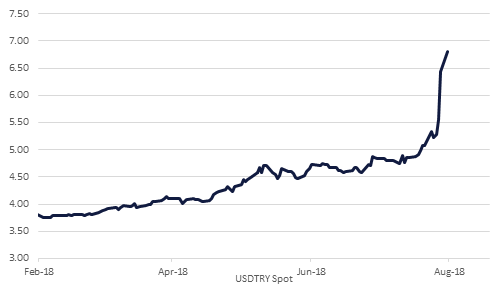
The headline CPI index in the US was stable at around 0.2% m/m (2.9% y/y), as falling gasoline and natural gas prices pushed energy costs down. Excluding food and energy, the core CPI index rose by 0.2% in July indicating 2.4% y/y from 2.3% in the previous month. Underlying data reflected a modest decline in apparel prices, which could be an early sign that the dollar’s appreciation is beginning to hold down import prices. That said, with core inflation touching a decade high, the case for the Federal Reserve raising rates two more times this year has further strengthened.
UK Q2 GDP estimate confirmed that the economy is on solid footing. The 0.4% quarterly rise in GDP in Q2 was in line with both the Bank of England and the consensus forecast. Though Brexit-related uncertainties could intensify over the coming months, if the EU negotiations stall or if Brexit turmoil results in a general election, this is generally not seen to be the central scenario. In absence of those developments, the economy is expected to grow between 1.3% - 1.5% this year.
Saudi Arabia’s budget deficit narrowed to just -USD 2bn in Q2 2018 (around -1% of GDP), significantly smaller than the same period in 2017. For H1 2018, the budget deficit was just under -3% of GDP, compared with -5.8% of GDP in H1 2017, despite a 27% increase in total spending. Higher oil prices and production were a key driver of the improved deficit, with oil revenues up 40% on H1 2017. Non-oil revenues grew 49.2% in H1 2018, with the introduction of VAT having a significant impact. It is unclear to what extent (if any) proceeds of the anti-corruption drive have been reflected in the H1 revenue figures.
A speech by Turkey’s Treasury and Finance Minister, Berat Albayrak, seemingly failed to reassure investors that the authorities would do what it takes to stem the ongoing sell-off in the lira, which crossed TRY 7.23/USD over the weekend before tracing steps back to TRY 6.95/USD this morning. While pledging central bank independence, the so-called new economic approach was somewhat lacking in detail. In appearances over the weekend, President Erdogan remained defiant despite rising concerns about a full-blown economic crisis.

Treasuries closed higher last week amid risk aversion following heightened geo-political tensions. Yields on the 2y UST, 5y UST and 10y UST closed at 2.60% (-4 bps w-o-w), 2.74% (-7 bps w-o-w) and 2.87% (-8 bps w-o-w).
Regional bonds traded in a tight range with the YTW on the Bloomberg Barclays GCC Credit and High Yield index remaining flat w-o-w at 4.45%. Credit spreads, however, widened 7 bps w-o-w to 175 bps.
In terms of new issuances, Abu Dhabi Islamic Bank is said to have hired banks for a USD 750mn perpetual Tier 1 sukuk.
The U.S. dollar gained against most of the other major currencies last week, the exception being Japanese Yen. Over the course of the week, the Dollar Index rose 1.20%, reaching 96.306 and in the process break and close above the former one year high of 95.652. This technical development creates the risk that the index may see further rises towards the 76.4% five-year Fibonacci retracement of 97.940. However, while the 14-day RSI (Relative Strength Indicator) is very bullish in momentum, it is currently at 69.09 and approaching overbought territory. This means that further gains may be initially restrained by profit taking on the dollar.
Regional equities started the week on a negative note as weak global cues weighed on investor sentiment. The DFM index and the Qatar Exchange lost -1.1% and -2.6% respectively. Drake & Scull (-5.6%) continued to drift lower to take its year to date losses to 79%. In Qatar, all stocks closed in negative territory with market heavyweights leading the decline. Qatar National Bank and Commercial Bank of Qatar dropped -4.7% and -4.1% respectively.
Oil prices declined over the course of last week despite a more than 1% gain for both WTI and Brent on Friday. Brent futures closed the week down 0.55% at USD 72.81/b while WTI fell 1.3% to end the week at USD 67.63/b. The IEA cautioned in its latest monthly market report that the current range oil prices have settled into may not last as supply is affected by US sanctions on Iran and unplanned disruptions elsewhere. The agency also raised its outlook for demand growth in 2019 to an acceleration from the 1.4m b/d expected this year.
US drillers were active in the last week, adding 10 rigs. It was the largest weekly increase in drilling rigs since May and takes the overall total to nearly 870 rigs. Investors were, however, less assured and cut their speculative positions on both Brent and WTI. Net length in WTI fell by 9.1k contracts and in Brent by more than 18.4k contracts.
Part of the decline in Brent net length will be down to negative roll yields at the front of the curve as the contango in the first three contracts persists. The 1-2 month spread in Brent futures has widened to as much as USD 0.6/b in recent days and closed the week at USD 0.3/b. WTI continues to hold onto its backwardation in the same spread although it has compressed from the more than USD 2/b spread it endured earlier in July.